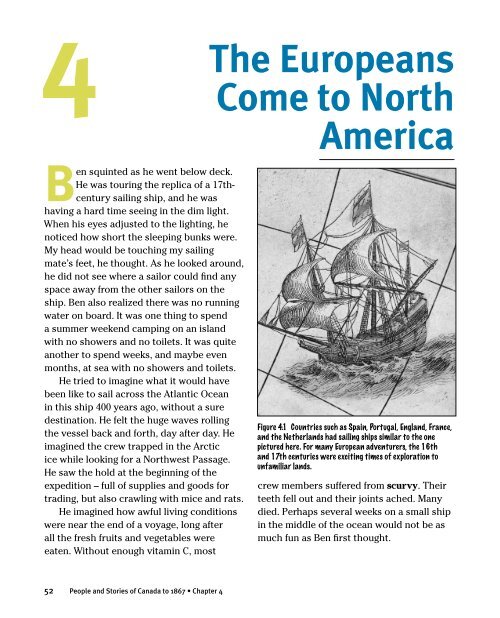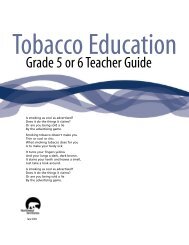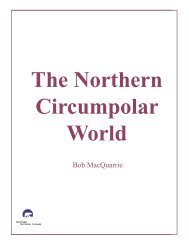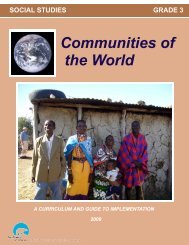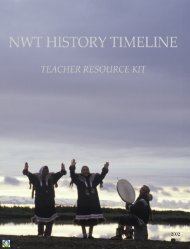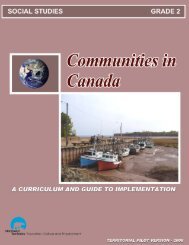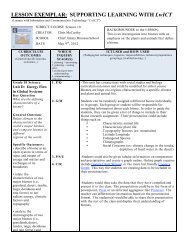The Europeans Come to North America 4
The Europeans Come to North America 4
The Europeans Come to North America 4
- No tags were found...
Create successful ePaper yourself
Turn your PDF publications into a flip-book with our unique Google optimized e-Paper software.
4<strong>The</strong> <strong>Europeans</strong><strong>Come</strong> <strong>to</strong> <strong>North</strong><strong>America</strong>Ben squinted as he went below deck.He was <strong>to</strong>uring the replica of a 17thcenturysailing ship, and he washaving a hard time seeing in the dim light.When his eyes adjusted <strong>to</strong> the lighting, henoticed how short the sleeping bunks were.My head would be <strong>to</strong>uching my sailingmate’s feet, he thought. As he looked around,he did not see where a sailor could find anyspace away from the other sailors on theship. Ben also realized there was no runningwater on board. It was one thing <strong>to</strong> spenda summer weekend camping on an islandwith no showers and no <strong>to</strong>ilets. It was quiteanother <strong>to</strong> spend weeks, and maybe evenmonths, at sea with no showers and <strong>to</strong>ilets.He tried <strong>to</strong> imagine what it would havebeen like <strong>to</strong> sail across the Atlantic Oceanin this ship 400 years ago, without a suredestination. He felt the huge waves rollingthe vessel back and forth, day after day. Heimagined the crew trapped in the Arcticice while looking for a <strong>North</strong>west Passage.He saw the hold at the beginning of theexpedition – full of supplies and goods fortrading, but also crawling with mice and rats.He imagined how awful living conditionswere near the end of a voyage, long afterall the fresh fruits and vegetables wereeaten. Without enough vitamin C, mostFigure 4.1 Countries such as Spain, Portugal, England, France,and the Netherlands had sailing ships similar <strong>to</strong> the onepictured here. For many European adventurers, the 16thand 17th centuries were exciting times of exploration <strong>to</strong>unfamiliar lands.crew members suffered from scurvy. <strong>The</strong>irteeth fell out and their joints ached. Manydied. Perhaps several weeks on a small shipin the middle of the ocean would not be asmuch fun as Ben first thought.52 People and S<strong>to</strong>ries of Canada <strong>to</strong> 1867 • Chapter 4
A Mi’kmaq s<strong>to</strong>ryA young Mi’kmaq woman had a strange dream.In it, she saw a small white island moving throughthe great waters. On this floating island weretrees and living beings. One figure, a male, s<strong>to</strong>odapart from the others. He was dressed in whiterabbit skins and had hair on his face.<strong>The</strong> next morning she <strong>to</strong>ld her dream <strong>to</strong> oneof her Elders, who was unable <strong>to</strong>interpret its meaning. Notlong afterward, the womansaw what looked like asmall island movingthrough the water<strong>to</strong>ward her village.<strong>The</strong> Mi’kmaq warriors <strong>to</strong>ok up their weapons andprepared <strong>to</strong> kill what they thought were bears onthe moving island. <strong>The</strong>y were surprised when theyrealized that the bears were actually white-facedmen, and the island was a large boat. One man,dressed in white, s<strong>to</strong>od apart from the others andmade signs of friendship.When the boat landed, the Elder brought the youngwoman <strong>to</strong> the man in white. <strong>The</strong> Elder asked her ifthis was the man in her dream. “Yes,” she replied.Figure 4.2For thousands of years, peoples ofdifferent backgrounds have worked, fought,and traded with each other. In this chapter,you will investigate some of the earliestmeetings between the Aboriginal peoplesof <strong>North</strong> <strong>America</strong> and the <strong>Europeans</strong> whoexplored and claimed these lands as theirown. You will also find out why <strong>Europeans</strong>wanted <strong>to</strong> expand their empires, why thiswas a good time for them <strong>to</strong> expand, andwhy <strong>Europeans</strong> came <strong>to</strong> <strong>North</strong> <strong>America</strong>.As you read, think about• what made the Renaissance soimportant <strong>to</strong> the people of Europeand the his<strong>to</strong>ry of the world• why <strong>Europeans</strong> were so keenon finding another route <strong>to</strong> Asia• how it became possible for <strong>Europeans</strong><strong>to</strong> sail far beyond Europe and theMiddle East<strong>The</strong> <strong>Europeans</strong> <strong>Come</strong> <strong>to</strong> <strong>North</strong> <strong>America</strong> 53
<strong>The</strong> Norse in <strong>North</strong> <strong>America</strong>As early as 800 CE, the Norse were on themove. Overcrowding and political unrestin Scandinavia led some people <strong>to</strong> searchfor new lands. Others were sent away aspunishment for crimes they had committed.In around 870, some of these emigrantslanded in Iceland where they built a colony.<strong>The</strong>y were a hardy and independent people.Eric the RedAround 982, a man named Eric the Redwas exiled <strong>to</strong> Iceland for a crime he hadcommitted in his homeland. Soon, he wasin trouble with the law again, and <strong>to</strong>ok <strong>to</strong>the seas, looking for a place <strong>to</strong> build a newsettlement. He landed in a place he namedGreenland, even though it was treeless,cold, and wintry. He thought that morepeople would come <strong>to</strong> live there if the landsounded like it was a warm and fertile place.Soon Eric the Red (so named becauseof his red hair and beard) was joinedby more than 300 new settlers fromIceland. <strong>The</strong> settlement on Greenlandwould survive for nearly 500 years. FromGreenland came the Norse settlers whowould explore <strong>North</strong> <strong>America</strong>.Who is who?Viking, Norse, Scandinavian: <strong>The</strong>se terms aredifferent ways of describing people from northernEurope. <strong>The</strong>ir raids on the rest of Europe earnedthem the name Viking, which is based on aNorwegian word for “pirate.” However, manyVikings were farmers, not pirates.about years earlier from a merchant namedBjarni Herjolfsson. He landed at a place hecalled Helluland (meaning “land of the flats<strong>to</strong>nes”), believed <strong>to</strong> be Baffin Island. Healso explored present-day Newfound landand Labrador. He named the most fertile ofthese s<strong>to</strong>pping points “Vinland.” Leif <strong>to</strong>oka shipment of lumber back <strong>to</strong> Green land,made his fortune, andnever returned.Leif the LuckyLeif Ericsson (son of Eric the Red) setsail from Greenland. He was searchingfor a tree-covered island he had heardFigure 4.3 Little is known of the Norseships that sailed across the AtlanticOcean a thousand years ago. Mosthist orians believe Leif Ericsson andothers travelled in a one-masted shipcalled a knarr. Knarrs were about 16–17metres long and 4–5 metres wide.54 People and S<strong>to</strong>ries of Canada <strong>to</strong> 1867 • Chapter 4
Figure 4.4 viking explorations. Vikings explored <strong>North</strong> <strong>America</strong> around 1000 CE.Thorvald the LucklessThorvald, Leif’s brother, did return <strong>to</strong>Vinland, however. Thorvald arrived withsupplies and 30 men who were determined<strong>to</strong> build a colony there. <strong>The</strong>y wereimpressed with the pastures, the trees,the fish, and the wild fruit.<strong>The</strong> SagasMuch of what we know about Norse explorationand settlement comes from the Sagas. <strong>The</strong>se ares<strong>to</strong>ries that were passed on from generation <strong>to</strong>generation. At first, the s<strong>to</strong>ries were <strong>to</strong>ld orally.Later, the s<strong>to</strong>ries were written down. For manyyears, no one knew if the s<strong>to</strong>ries were true.However, archaeologists have found things thatcan be read about in the Sagas. Some of the Sagasare actually fun <strong>to</strong> read. In one, we learn that Leif’smother-in-law was named “Thorbjorg the shipchested.”We also find out that Leif’s father andgrandfather spent time in exile for murder.<strong>The</strong>y also found out that the land wasalready inhabited. In the first recordedencounter with Aboriginal peoples ofLabrador, the Norse stumbled across ninemen sleeping under boats. <strong>The</strong>y killed eigh<strong>to</strong>f them, but one escaped and returned withothers <strong>to</strong> fight the intruders. Thorvald waswounded and died as a result of this skirmish.Those who survived returned <strong>to</strong> Greenland.<strong>The</strong> Vinland settlementIn about 1012, a group of approximately160 Greenlanders sailed <strong>to</strong> Vinland <strong>to</strong>establish a permanent colony there.Although they traded with Aboriginalpeoples, the two groups sometimes foughtand even killed each other. After a while,the Norse decided <strong>to</strong> leave Vinland andreturn <strong>to</strong> their homeland.<strong>The</strong> <strong>Europeans</strong> <strong>Come</strong> <strong>to</strong> <strong>North</strong> <strong>America</strong> 55
L’Anse aux MeadowsFor a long time, scholars believed that the Norsehad built a settlement in the place we now callNewfoundland. Many other people, however,thought this was just a s<strong>to</strong>ry. <strong>The</strong>n, in 1960,archaeologists uncovered an ancient Norsesettlement in Newfoundland. This settlement iscalled L’Anse aux Meadows. It proved, for the firsttime, that Vikings had crossed the Atlantic Oceanand landed in <strong>North</strong> <strong>America</strong> around 1000 ce,500 years before any other <strong>Europeans</strong> would try.Is L’Anse aux Meadows the land that Leif namedVinland? No one knows for sure, although thereare several theories.<strong>The</strong>ory 1: <strong>The</strong> vin in Vinland refers <strong>to</strong> wine, orgrapes. Since no one has ever grown grapes asfar north as Newfoundland and Labrador, Vinlandmust be located in a yet-<strong>to</strong>-be-discovered placefarther south.<strong>The</strong>ory 2: L’Anse aux Meadows is Vinland.Vin refers <strong>to</strong> pastures, of which Newfoundlandand Labrador have plenty.<strong>The</strong>ory 3: Vin does refer <strong>to</strong> wine,or grapes. <strong>The</strong> Norse thoughtthe wild berries growing inabundance in the area, suchFigure 4.5 Artifacts such as these brooches and cloakpin have allowed his<strong>to</strong>rians <strong>to</strong> identify where the Norseexplorers landed in the New World.as crowberries, partridgeberries, and blueberries,would make good wine.<strong>The</strong>ory 4: Like father, like son? Greenland wasnamed by Leif Ericsson’s father, Eric the Red, eventhough it was treeless, cold, and wintry. He thoughtthat more people would come <strong>to</strong> live there if theland sounded like it was a warm and fertile place.Perhaps Leif Ericsson named L’Anse aux Meadows“Vinland” because he thought people would settlethere if they believed the place was warm enough<strong>to</strong> grow grapes.Figure 4.6 Today, the his<strong>to</strong>ric site of L’Anse aux Meadows features buildings reconstructed <strong>to</strong> look like those from 1000 CE.Archaeologists have concluded that early Norse settlers lived in sod houses like those in the picture above.56 People and S<strong>to</strong>ries of Canada <strong>to</strong> 1867 • Chapter 4
<strong>The</strong> RenaissanceBetween the 14th century and the 16thcentury, most of Europe emerged from theMiddle Ages and with new inventions andideas experienced a “rebirth.”<strong>The</strong> printing press changed the waypeople learned and communicated. For thefirst time, people, other than small groups ofpriests and scholars, could buy books. Thisresulted in new ideas spreading faster thanever before.New inventions also affected the economyof Europe, which, in turn, changedthe way people lived. <strong>The</strong> invention of thetelescope helped people discover newthings about science and astronomy. <strong>The</strong>ybegan <strong>to</strong> question long-standing beliefs,including the idea that the sun revolvedaround the earth.Ship designs improved. People wereable <strong>to</strong> explore and sail farther than theyever had before. New instruments like thequadrant, sextant, and compass helpedsailors determine direction easily, ensuringquicker and safer ocean voyages. Even theBasques’ method of keeping cod from goingbad had an impact. Fish, which providedsailors with a good source of protein, didnot spoil quickly when it was salted.Spices like cinnamon, ginger, and pepperwere no longer just for the rich. <strong>The</strong> growingmiddle class could now afford <strong>to</strong> buy them.However, the overland trip <strong>to</strong> obtain spices<strong>to</strong>ok years <strong>to</strong> complete, and many of theroutes were dangerous because of bandits.<strong>Europeans</strong> wanted <strong>to</strong> find a safe route by sea<strong>to</strong> the spice-growing countries in Asia andIndonesia. <strong>The</strong>y thought that if they founda western sea passage <strong>to</strong> Asia, they couldeasily get the things they wanted from theEast. It was like a great big treasure hunt.Whoever found the sea route <strong>to</strong> the East(called the <strong>North</strong>west Passage) wouldbe rewarded by his king and queen.This period of time is called theRenaissance.Pepper was especiallyprized and, literally,worth its weight in gold.When Columbus returnedfrom his voyage <strong>to</strong> theNew World, he brought chilis, which weregrown by the Aboriginal peoples. In aneffort <strong>to</strong> convince his benefac<strong>to</strong>rs thathis trip had been worth it, he called thechilis “red peppers.”?did youknow ?Figure 4.8 Spices from AsiaTravel <strong>to</strong> the western world … is a consequenceof the long struggle of the nations of Europevying for supremacy and control of tradewith the East …. For all those who pushedback the limits of the unknown world, thereis always the glitter of gold and the odour offar fetched spices.— Sir Walter Raleigh, 160558 People and S<strong>to</strong>ries of Canada <strong>to</strong> 1867 • Chapter 4
Figure 4.9 This painting, <strong>The</strong> Ambassadors, was painted in 1533 by Hans Holbein the Younger (1497-1543). <strong>The</strong> objects in thepainting show some of the advances made during the Renaissance. Inventions include a sextant and astrolabe, navigationinstruments that allowed sailors <strong>to</strong> travel the world’s oceans. Books show how new ideas could be spread <strong>to</strong> everyone. <strong>The</strong>globes show how knowledge of the world was growing. <strong>The</strong> carpets on the floor and table reflect the ongoing trade betweenEurope and East Asia.<strong>The</strong> power of the ChurchIn the mid-1500s, most <strong>Europeans</strong> followedone of two Christian traditions. RomanCatholics followed the traditional teachingsof the Roman Catholic Church. In the early1500s, some people had disagreed with theCatholic Church and formed their owngroup, known as the Protestants (becausethey had protested some of the CatholicChurch’s main teachings). This was important<strong>to</strong> exploration, because the Catholicpopes made decisions about who couldclaim what lands in the New World.Throughout Europe, countries such asFrance, Spain, and Portugal remained Catholic.Other countries such as England and theNetherlands followed the Protestant faith.<strong>The</strong> <strong>Europeans</strong> <strong>Come</strong> <strong>to</strong> <strong>North</strong> <strong>America</strong> 59
<strong>The</strong> EmpiresDuring the Renaissance, kings and queenshired explorers and crews <strong>to</strong> expand theirempires, or the lands they controlled allover the world. <strong>The</strong>y competed for newlands, slaves, trade routes, and preciousgoods like spices and gold. <strong>The</strong>y also wanted<strong>to</strong> spread their religions <strong>to</strong> people in newlands. <strong>The</strong> public loved <strong>to</strong> hear about exoticplaces, and many explorers wrote s<strong>to</strong>riesbased on their experiences. Becausesensational s<strong>to</strong>ries sold, some explorerseven altered their adventures <strong>to</strong> includes<strong>to</strong>ries of fantastical people.Sometimes, explorers made their tripssound more successful than they were. Bydoing this, many got sponsors <strong>to</strong> fund theirexpeditions. One explorer, for example,reported that the Aboriginal peoples of<strong>North</strong> <strong>America</strong> were Chinese. Others wrotethat they had found a river in <strong>North</strong> <strong>America</strong>that would take them <strong>to</strong> the Pacific andacross Asia. In truth, no one had any ideahow wide <strong>North</strong> <strong>America</strong> was, and theearliest maps often show coastline witha rather skinny strip of land (see p. 64).Figure 4.10 Chris<strong>to</strong>pher Columbus travelled <strong>to</strong> Spain <strong>to</strong> findbacking for his travels. King Ferdinand and Queen Isabellawere eager <strong>to</strong> find a way <strong>to</strong> the riches of Asia and so fundedColumbus’s expeditions <strong>to</strong> search for a passage <strong>to</strong> Asia.At first, the search for a <strong>North</strong>westPassage was the reason for much of early<strong>North</strong> <strong>America</strong>n exploration. Soon, however,explorers began <strong>to</strong> realize the enormous sizeof <strong>North</strong> <strong>America</strong>. <strong>The</strong>y knew it would beboth costly and difficult <strong>to</strong> find a way aroundor through the continent. At about the sametime, they also discovered new riches onthe lands that they were exploring. Gold andsilver from South and Central <strong>America</strong>, andluxurious furs from <strong>North</strong> <strong>America</strong> would bevaluable goods in Europe.Explorers began claiming more andmore land for the rulers of the countriessponsoring their expeditions. In turn, therulers started <strong>to</strong> plan colonies in thesenewly claimed lands. <strong>The</strong>y wanted <strong>to</strong> makesure they could control both the peopleand the riches they found there.Some of the countries that exploredduring this period of exploration arediscussed below.PortugalOne of the first people <strong>to</strong> finance explorationsduring this time was Henry the Naviga<strong>to</strong>r,the king of Portugal. During the 1430s,he founded a court <strong>to</strong> which he invitedEurope’s best car<strong>to</strong>graphers (mapmakers),shipbuilders, astronomers, instrumentmakers, and sailors. Portugal, located onthe Atlantic Ocean, was active in explorationduring the 1400s and 1500s.SpainEager <strong>to</strong> find a way <strong>to</strong> the riches of Asia,the royal court of Spain sponsored manyexpeditions <strong>to</strong> search for a passage <strong>to</strong> the East.When the Spaniards found gold and silver inSouth <strong>America</strong> and Central <strong>America</strong>, they60 People and S<strong>to</strong>ries of Canada <strong>to</strong> 1867 • Chapter 4
gave up on their search for the <strong>North</strong>westPassage and put their energy in<strong>to</strong> miningthese riches. Spain became very wealthy.<strong>The</strong> Aztec and Maya civilizations ofMexico and Central <strong>America</strong> and the Incaof South <strong>America</strong> had flourished before theSpaniards arrived. But European illnessesand sophisticated weapons would destroythe civilizations.England and FranceBoth England and France began explorationlater than Spain and Portugal. <strong>The</strong>ysponsored explorations after hearingreports of gold in South <strong>America</strong>. By thistime, however, Spain and Portugal had laidclaim <strong>to</strong> South <strong>America</strong> and Central <strong>America</strong>.England and France decided <strong>to</strong> focus onfinding the <strong>North</strong>west Passage <strong>to</strong> Asia.<strong>The</strong>y had different ways of pursuing theirinterests in <strong>North</strong> <strong>America</strong>. <strong>The</strong>ir activitiesare outlined in chapters 5 and 6.Figure 4.12 <strong>Europeans</strong> expected that people in the New Worldwould look very different from themselves. <strong>The</strong> artist ofthis painting imagined people’s heads were in the middleof their chests.<strong>The</strong> Netherlands<strong>The</strong> Netherlands entered the race for spicesand wealth during the 1600s. <strong>The</strong> Dutchwere involved in the <strong>North</strong> <strong>America</strong>n furtrade, but when Spain and Portugal left Asia<strong>to</strong> explore the <strong>America</strong>s, the Netherlands<strong>to</strong>ok their place. <strong>The</strong> Netherlands traded allover Asia, largely through the activities ofthe powerful Dutch East Indies Company.Figure. 4.11 european empires. This map shows the empires of England, France, Spain, the Netherlands, and Portugal aroundthe mid 17th century.<strong>The</strong> <strong>Europeans</strong> <strong>Come</strong> <strong>to</strong> <strong>North</strong> <strong>America</strong> 61
Giovanni da VerrazanoVerrazano (1485 –1528) was an Italianwho sailed for Francein search of the<strong>North</strong>west Passage.He explored muchof the eastern coas<strong>to</strong>f <strong>North</strong> <strong>America</strong>, all the way up <strong>to</strong>Newfoundland, which he claimed forFrance. He noted in a letter <strong>to</strong> his kingthat colonization would be difficultbecause of the Aboriginal peoplesliving along the coast. He died at thehands of the Spaniards, who hangedhim for piracy. Some his<strong>to</strong>rians thinkJacques Cartier travelled with him <strong>to</strong>Newfoundland. We know that Cartierfollowed up Verrazano’s explorationswith his own ship in 1534.Martin FrobisherFrobisher (1535– 1594),who first went <strong>to</strong> seaat the age of nine,sailed for England.He travelled <strong>to</strong> <strong>North</strong><strong>America</strong> in searchof the <strong>North</strong>westPassage, but he was sidetracked in theArctic at Baffin Island by what he thoughtwas gold. He filled his ships with <strong>to</strong>ns ofgold-speckled rock and headed back <strong>to</strong>England. <strong>The</strong>re, he found out that whathe thought was gold was actually ironpyrite, a worthless rock also known as“fool’s gold.” Many of his backers werefinancially ruined, and the rock waseventually used for gravel.Frobisher died after being wounded ina battle against Spain, and his internalorgans were buried separately fromthe rest of his body. No one knowsthe reason for this.Henry HudsonSir Francis DrakeDrake (1540 – 1596)sailed for England.In England he wasregarded as a hero forhis explorations, butthe Spaniards sawhim as a pirate anddespised him. Drakefirst went <strong>to</strong> sea as a cabin boy when hewas about 13 years old. Although theexplorer Ferdinand Magellan is creditedwith being the first person <strong>to</strong> sail all theway around the world, Sir Francis Drakewas the first <strong>to</strong> complete the trip and live.(Magellan died en route.) In 1580, he wasknighted by Queen Elizabeth I.Hudson (1565 – 1611)sailed under bothNetherlands’ andEngland’s flags.He explored a largebody of water, nowcalled Hudson Bay,thinking that he had found the <strong>North</strong>westPassage. He and his crew spent thewinter in Hudson Bay. When springarrived and the ice melted, his crewwanted <strong>to</strong> return <strong>to</strong> Europe. Hudson,however, was determined <strong>to</strong> exploremore of the large bay. His crew, tiredof searching for the passage <strong>to</strong> theEast, mutinied. Hudson, his son, anda few loyal crewmen were last seenalive in a small boat drifting on thebay. <strong>The</strong> mutineers returned <strong>to</strong> England.Several of them later returned forfurther explorations.<strong>The</strong> <strong>Europeans</strong> <strong>Come</strong> <strong>to</strong> <strong>North</strong> <strong>America</strong> 63
Figure 4.14 Look at a map of presentday<strong>North</strong> <strong>America</strong>, and compare itwith this map. In 1550, mapmakersdid not have instruments (such assatellite images) that present-daymapmakers have <strong>to</strong> help them drawmaps. <strong>The</strong> person who made this mapbelieved <strong>North</strong> <strong>America</strong> was verynarrow. Like many people of the day,the mapmaker probably thought<strong>North</strong> <strong>America</strong> would be easy <strong>to</strong> cross<strong>to</strong> reach the riches of the Orient.Cartier and Donnacona –Friends and Enemies?In 1534, Jacques Cartier (1493–1557) setsail from St. Malo, France. His voyage, paidfor by the king of France, was “<strong>to</strong> discovercertain islands and lands where it is saidthat a great quantity of gold, and otherprecious things, are <strong>to</strong> be found.” He wasalso determined <strong>to</strong> find a <strong>North</strong>west Passage<strong>to</strong> Asia. Jacques Cartier gets credit as thefirst European <strong>to</strong> enter (and name) theSt. Lawrence River.Cartier made three voyages <strong>to</strong> <strong>North</strong><strong>America</strong>. He explored the northeast coast of<strong>North</strong> <strong>America</strong>, sailed up the St. LawrenceRiver <strong>to</strong> Hochelaga (called Montreal <strong>to</strong>day),and tried <strong>to</strong> establish a colony, which hecalled Charlesbourg-Royal, between Stadacona(<strong>to</strong>day’s Quebec City) and Hochelaga.On his first voyage in 1534, Cartier sailedin<strong>to</strong> Gaspé Bay. <strong>The</strong>re, he met severalhundred Aboriginal people. Relations startedout well. However, when Cartier erecteda nine-metre-high cross (a symbol ofChristianity) and claimed the area for France,Donnacona, leader of the Wendat, becamesuspicious. As Cartier prepared his returnvoyage, he kidnapped Donnacona’s sonsDomagaya and Taignoagny and broughtthem back <strong>to</strong> France for the winter. Cartierwanted <strong>to</strong> prove <strong>to</strong> people in France thathe had found new lands and peoples. Healso wanted his captives <strong>to</strong> learn <strong>to</strong> speakFrench, so they could act as interpreters.He promised Donnacona he would bringhis sons back the following year.On Cartier’s second trip, in 1535, heentered the St. Lawrence River for thefirst time. He then sailed <strong>to</strong> the village ofStadacona, where Donnacona and his sonswere reunited. Cartier also went fartherupriver <strong>to</strong> Hochelaga.As it was getting late in the season,Cartier decided <strong>to</strong> stay the winter. He andhis men were ill-prepared for the long, cold64 People and S<strong>to</strong>ries of Canada <strong>to</strong> 1867 • Chapter 4
Jacques Cartier was thefirst person <strong>to</strong> refer <strong>to</strong> theland at the mouth of andalong the St. LawrenceRiver as “Canada.” Canadacomes from the Algonquian word Kanata,which means “village.”?did youknow ?ConclusionMost of the explorers discussed in thischapter, and many others we have notnamed, led the European expansion in<strong>to</strong>new areas. <strong>The</strong> leaders of the empires theyrepresented thought this would be a goodway <strong>to</strong> (1) find the <strong>North</strong>west Passage<strong>to</strong> Asia, (2) find gold and other preciousmetals, (3) convert Aboriginal peoples<strong>to</strong> European faiths, and (4) claim landfor their empires.Jacques Cartier did not find gold likethe Spaniards did in South <strong>America</strong> andCentral <strong>America</strong>. He did not find themythical kingdom of Saguenay. Cartierdid, however, open the way for explorersof the next century.In the next chapter, join Sara and Benas they explore the French presence in<strong>North</strong> <strong>America</strong> and learn about the roleFrance played in colonizing the land thatwould come <strong>to</strong> be called “Canada.”Figure 4.17 cartier’s three voyages<strong>The</strong> <strong>Europeans</strong> <strong>Come</strong> <strong>to</strong> <strong>North</strong> <strong>America</strong> 67


